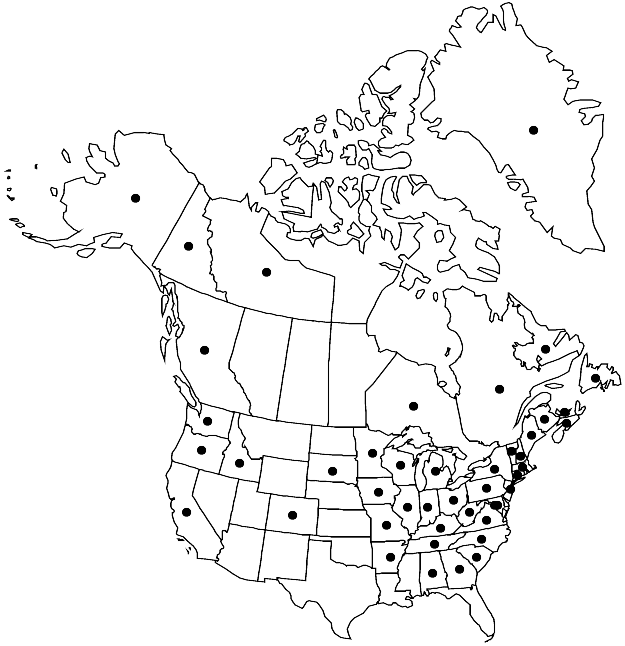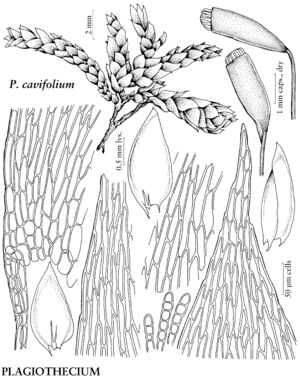Plagiothecium cavifolium
J. Hattori Bot. Lab. 33: 360. 1970.
Plants in thin to dense mats, pale green to yellowish, glossy or rarely dull. Stems to 4 cm, 1–4 mm wide across leafy stem, erect or sometimes prostrate, julaceous or rarely somewhat complanate-foliate. Leaves erect or sometimes spreading, imbricate or rarely distant, ovate or oblong-ovate, symmetric, strongly concave, rarely nearly flat, 1–3 × 0.4–1.4 mm; margins plane or often narrowly recurved nearly to apex, entire or rarely serrulate at apex; apex abruptly acute or slender-acuminate, not abruptly contracted, often recurved; costa with one branch often reaching mid leaf, sometimes appearing single with one branch poorly developed, or rarely ecostate; alar cells rectangular, 28–70 × 12–22 µm, in 1–5 vertical rows, terminating in 1 cell at base, region triangular; medial laminal cells 60–161 × 7–17 µm. Specialized asexual reproduction sometimes present as propagula, 36–110 × 9–17 µm, of 2–7 cells borne in leaf axils. Sexual condition dioicous, rarely fruiting. Seta light brown to red, 1–2.6 cm, straight or somewhat curved. Capsule erect to inclined, light brown to dark red when mature, straight or arcuate, 1–2.5 × 0.3–0.8 mm, smooth or often striate or wrinkled, strongly wrinkled at neck; operculum rostrate, 0.8–1 mm; endostome cilia 1–3. Spores 9–14 µm.
Phenology: Capsules mature spring–summer.
Habitat: Shaded soil or humus overlying boulders and cliffs, rotten logs, stumps, base of trees
Elevation: low to high elevations (40-2000 m)
Distribution

Greenland, B.C., N.B., Nfld. and Labr., N.W.T., N.S., Ont., P.E.I., Que., Yukon, Ala., Alaska, Ark., Calif., Colo., Conn., D.C., Ga., Idaho, Ill., Ind., Iowa, Ky., Maine, Md., Mass., Mich., Minn., Mo., N.H., N.J., N.Y., N.C., Ohio, Oreg., Pa., S.C., S.Dak., Tenn., Vt., Va., Wash., W.Va., Wis., Europe, Asia.
Discussion
Plagiothecium cavifolium is distinguished from other North American species of this genus by its concave, recurved leaf apices on julaceous stems. The stems are often flagelliform. The California record is from a report by K. McGrew (unpubl.). Plagiothecium cavifolium is very similar to P. sylvaticum (Bridel) Schimper of Europe; P. cavifolium is usually julaceous with concave leaves that have narrow medial cells, 7–17 µm wide, and P. sylvaticum is complanate-foliate with flat leaves that have broader medial cells, 12–22 µm wide.
Selected References
None.
